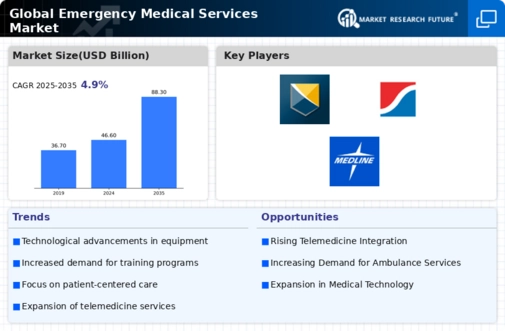Market Growth Projections
The Global Emergency Medical Services Market Industry is poised for substantial growth, with projections indicating an increase from 46.6 USD Billion in 2024 to 88.3 USD Billion by 2035. This growth trajectory suggests a compound annual growth rate (CAGR) of 5.98% from 2025 to 2035. Factors contributing to this expansion include advancements in technology, increased government funding, and a growing awareness of the importance of emergency medical services. As the market evolves, it is likely to attract further investments, enhancing the quality and accessibility of emergency medical services globally.
Government Initiatives and Funding
Government initiatives and funding significantly influence the Global Emergency Medical Services Market Industry. Many countries are prioritizing emergency medical services as part of their public health strategies. For instance, increased budget allocations for emergency medical services have been observed in various nations, aimed at improving infrastructure and training. Such investments not only enhance service delivery but also ensure that emergency medical personnel are well-equipped to handle crises effectively. This proactive approach by governments is expected to foster a robust growth environment for the Global Emergency Medical Services Market Industry, aligning with the projected market expansion.
Aging Population and Increased Healthcare Needs
The aging population worldwide is a significant factor influencing the Global Emergency Medical Services Market Industry. As the demographic landscape shifts, there is a corresponding rise in healthcare needs, particularly among older adults who are more susceptible to medical emergencies. This demographic trend necessitates a robust emergency medical response system capable of addressing the unique challenges posed by an aging population. Consequently, healthcare systems are adapting to meet these needs, which is expected to drive market growth. The anticipated increase in market size from 46.6 USD Billion in 2024 to 88.3 USD Billion by 2035 underscores the urgency of enhancing emergency medical services to cater to this demographic.
Growing Awareness of Emergency Medical Services
The growing awareness of the importance of emergency medical services is a pivotal driver for the Global Emergency Medical Services Market Industry. Public education campaigns about the significance of timely medical intervention during emergencies have led to increased utilization of these services. For instance, community training programs on CPR and first aid have empowered citizens to act swiftly in emergencies, thereby increasing the demand for professional emergency medical services. This heightened awareness is likely to contribute to the market's growth trajectory, as more individuals recognize the value of immediate medical assistance in critical situations.
Increasing Demand for Emergency Medical Services
The Global Emergency Medical Services Market Industry experiences a notable surge in demand, primarily driven by the rising incidence of emergencies and accidents. As urban populations grow, the need for efficient emergency response systems becomes paramount. For instance, in 2024, the market is projected to reach 46.6 USD Billion, reflecting the urgent need for advanced medical services. This demand is further amplified by the increasing prevalence of chronic diseases, necessitating timely medical interventions. Consequently, governments and healthcare organizations are investing in enhancing their emergency medical capabilities, thereby propelling the growth of the Global Emergency Medical Services Market Industry.
Technological Advancements in Emergency Medical Services
Technological innovations play a crucial role in shaping the Global Emergency Medical Services Market Industry. The integration of advanced communication systems, telemedicine, and real-time data analytics enhances the efficiency of emergency response teams. For example, the use of mobile applications for dispatching ambulances has significantly reduced response times. Moreover, the adoption of electronic health records allows paramedics to access patient information swiftly, improving treatment outcomes. As these technologies evolve, they are likely to attract further investments, contributing to the anticipated market growth from 46.6 USD Billion in 2024 to 88.3 USD Billion by 2035, with a CAGR of 5.98% from 2025 to 2035.















Leave a Comment